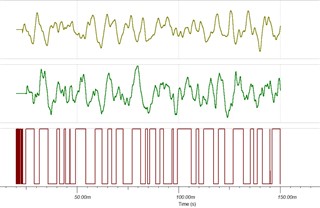Tool/software:
Hi everyone,
I’m working with the LM111 comparator and testing it using two noise signals generated from .wav files. Both inputs swing roughly within ±800 mV and are connected to the inverting and non-inverting inputs of the LM111.
In the attached screenshot:
-
The top waveform (yellow) is the non-inverting input
-
The middle waveform (green) is the inverting input
-
The bottom waveform (red) is the LM111 output
What’s confusing me is the output — it’s showing a lot of fast transitions even when the inputs look fairly steady or only slightly crossing. I'm wondering if this is due to the nature of the noise signals, or if it's hitting some sort of frequency or response limitation of the comparator.
A few questions I have:
-
Is this kind of response normal for the LM111 with fast-changing or noisy analog inputs?
-
Could this be related to the lack of hysteresis, or maybe the input offset or slew rate limits?
-
Would adding external hysteresis or filtering help stabilize the output in this kind of use case?
Would really appreciate any guidance or suggestions. Let me know if sharing the .wav files would help.
Thanks!


